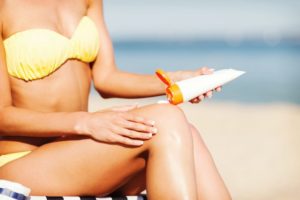Stopping and Reversing Sun Damage
Gone are the carefree days of believing that sun exposure is harmless. In healthy doses, sunlight can reduce stress, boost immunity and metabolism, and help the body synthesize vitamin D. In excess, sun exposure can wreak havoc on skin, as well as the immune system. We know now that sun damage continues after you go back inside. We also know that the effort expended by the body to repair DNA damage caused by sun exposure produces harmful byproducts known as free radicals. Free radicals are the orchestrators of wrinkled and sagging skin, and a pre-cursor to more serious health problems down the road. There are two phases in sun damage treatment: prevention and reversal, and there are a multitude or products that can aid in doing both, when used in conjunction with the development of better sun habits.
Sun Damage Prevention

Use common sense with your sunblock. Plan your activities in direct sunlight in the morning or late afternoon; 10AM-2PM is the block of time where the sun’s rays are harshest. Wear a hat, preferably wide-brimmed, that will protect your face, shoulders, and chest. Polarized sunglasses will help reduce damage to the thin tissue of the eyelid and cornea. If you do develop moles or notice significant changes to your skin after sun exposure, consult your dermatologist as soon as possible to head off complications.
Reversing the Effects of Sun Damage
If you have already fallen victim to sun damage, there are ways to partially reverse the process. Treatments such as Juvederm or Restylane can reduce the appearance of wrinkles and sagging skin over time. Your diet can also be used as a weapon against skin aging: berries, nuts, leafy greens, and—surprisingly—brewed coffee are all antioxidant-rich foods that will minimize sun damage during exposure and reverse damage long after.
It is much easier to prevent sun damage than it is to reverse it. Some people show few immediate side effects to prolonged sun exposure, but 40-50% of Americans who live to age 65 will develop some form of skin cancer according to the Skin Cancer Foundation. The Foundation also claims that almost 5 million people are treated for some form of skin cancer in the U.S. every year. Many of skin cancer’s iterations are easily treated: some, such as melanoma, are not. An estimated 10,000 people will lose their lives to melanoma this year. With some simple routine and product regimen changes, the harmful complications of excess sun exposure can be reversed or prevented altogether.


